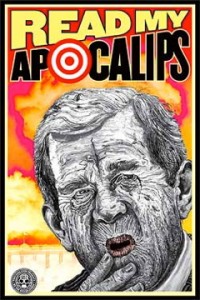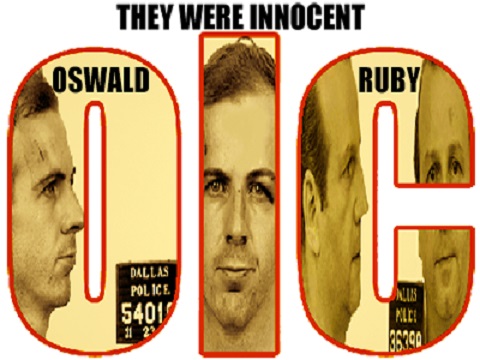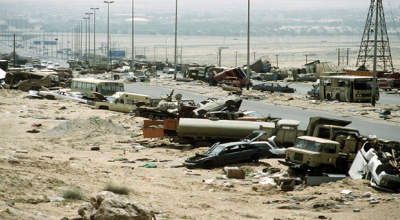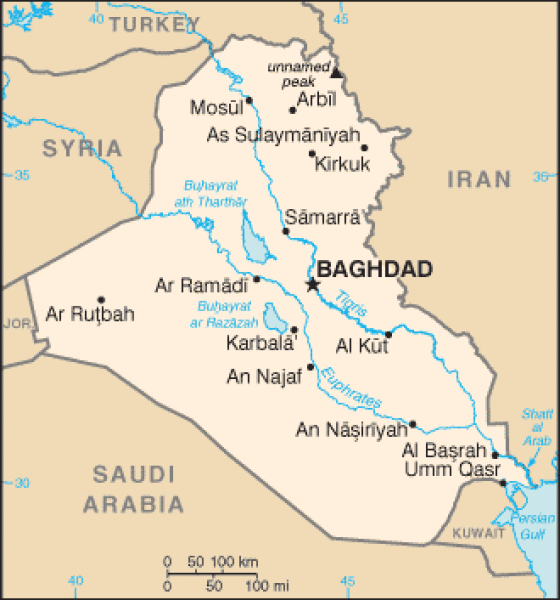This article was first crossposted in March 2018.
The numbers of casualties of U.S. wars since Sept. 11, 2001 have largely gone uncounted, but coming to terms with the true scale of the crimes committed remains an urgent moral, political and legal imperative, argues Nicolas J.S. Davies.
How many people have been killed in America’s post-9/11 wars? I have been researching and writing about that question since soon after the U.S. launched these wars, which it has tried to justify as a response to terrorist crimes that killed 2,996 people in the U.S. on September 11th 2001.
But no crime, however horrific, can justify wars on countries and people who were not responsible for the crime committed, as former Nuremberg prosecutor Ben Ferencz
patiently explained to NPR at the time.
“The Iraq Death Toll 15 Years After the U.S. Invasion” which I co-wrote with
Medea Benjamin, estimates the death toll in Iraq as accurately and as honestly as we can in March 2018. Our estimate is that about 2.4 million people have probably been killed in Iraq as a result of the
historic act of aggression committed by the U.S. and U.K. in 2003. In this report, I will explain in greater detail how we arrived at that estimate and provide some historical context. In Part 2 of this report, I will make a similar up-to-date estimate of how many people have been killed in America’s other post-9/11 wars.
Mortality Studies vs Passive Reporting
In each of those accounts, I explained that estimates of war deaths regularly published by UN agencies, monitoring groups and the media are nearly all based on fragmentary “passive reporting,” not on comprehensive mortality studies.
Of the countries where the U.S. and its allies have been waging war since 2001, Iraq is the only country where epidemiologists have conducted mortality studies based on the best practices that they have developed and used in other war zones (like Angola, Bosnia, the Democratic Republic of Congo, Guatemala, Kosovo, Rwanda, Sudan and Uganda). In all these countries, as in Iraq, the results of comprehensive epidemiological studies revealed between 5 and 20 times more deaths than previously published figures based on passive reporting.
Body Count: Casualty Figures After 10 Years of the ‘War on Terror’ , a report published by Physicians for Social Responsibility (PSR) in 2015 found that the
2006 Lancet study was the most comprehensive and reliable mortality study conducted in Iraq, based on its study design, the experience and independence of the research team, the short time elapsed since the deaths it documented and its consistency with other measures of violence in occupied Iraq. That study estimated that about 601,000 Iraqis were killed in the first 39 months of war and occupation in Iraq, while the war had also caused about 54,000 non-violent deaths.
In the other countries affected by America’s post-9/11 wars, the only reports of how many people have been killed are either compiled by the UN based on investigations of incidents reported to local UN Assistance Missions (as in Iraq and Afghanistan), or by the UN or independent monitoring groups like the
Syrian Observatory for Human Rights,
Iraq Body Count (IBC) and
Airwars based on passive reports from government agencies, health facilities or local or foreign media.
These passive reports are regularly cited by UN and government agencies, media and even by activists as “estimates” of how many people have been killed, but that is not what they are. By definition, no compilation of fragmentary reports can possibly be a realistic estimate of all the people killed in a country ravaged by war.
At best, passive reports can reveal a minimum number of war deaths. But that is often such a small fraction of actual deaths that it is highly misleading to cite it as an “estimate” of the total number of people killed. This is why epidemiologists have instead developed scientific sampling methods that they can use to produce accurate estimates of war deaths through statistically valid mortality studies.
The huge disparities epidemiologists have found between the results of mortality studies and passive reporting (between 5:1 and 20:1) have been consistent across many different war zones all over the world. In countries where Western governments are not responsible for the state of war, there has been no political controversy over these results, and they are regularly cited by Western officials and media.
But Western politicians and media have dismissed and marginalized the results of mortality studies in Iraq for political reasons. The U.S. and U.K.’s responsibility for the state of war in Iraq means that the scale of the slaughter is a serious matter of political and criminal responsibility for senior officials who chose to ignore legal advice that the invading Iraq would be
“a crime of aggression”.
In 2006,
British officials were advised by Sir Roy Anderson, the Chief Scientific Adviser to the U.K.’s Ministry of Defense, that “The (Lancet) study design is robust and employs methods that are regarded as close to ‘best practice’ in this area…”

President George W. Bush in poster by Robbie Conal (robbieconal.com)
The
BBC obtained copies of emails in which British officials admitted that the study was “likely to be right,” and “the survey methodology used here cannot be rubbished, it is a tried and tested way of measuring mortality in conflict zones.” But the same officials immediately launched a campaign to discredit the study. President George W. Bush publicly declared, “I don’t consider it a credible report,” and the subservient U.S. corporate media quickly dismissed it.
In
“Playing Games With War Deaths” in 2016, I concluded, “As with climate change and other issues, UN officials and journalists must overcome political pressures, come to grips with the basic science involved, and stop sweeping the vast majority of the victims of our wars down this Orwellian “memory hole.”
Some have argued that it is not important to know whether our wars have killed tens of thousands of people or millions, since all deaths in war are a tragic loss of life and we should just mourn them, instead of quibbling over numbers. But as the authors of
Body Count noted,
“The numbers relayed by the media should in themselves be terrifying enough… But apparently they are still perceived as tolerable and, moreover, easy to explain given the picture of excessive religiously motivated violence. The figure of 655,000 deaths in the first three war years alone, however, clearly points to a crime against humanity approaching genocide.”
Most Americans would say that it matters whether Germany’s role in the Second World War led to millions of violent deaths or only ten thousand. Suggesting the latter is actually
a crime in Germany and several other countries.
So American politicians, journalists and members of the public who say it doesn’t matter how many Iraqis have been killed are consciously or unconsciously applying a morally untenable double standard to the consequences of our country’s wars precisely because they are our country’s wars.
A War That Keeps Killing
While the
2006 Lancet study of post-invasion mortality in Iraq is recognized by independent experts like the authors of
PSR’s Body Count report as the most accurate and reliable estimate of war deaths in any of our post-9/11 wars, it was conducted nearly 12 years ago, after only 39 months of war and occupation in Iraq. Tragically, that was nowhere near the end of the deadly and catastrophic results of the U.S. and U.K.’’s historic act of aggression.
The
2006 Lancet study documented ever-increasing violence in occupied Iraq between 2003 and 2006, and many other metrics indicate that the escalation of violence in Iraq continued at least until the end of the U.S. “surge” in 2007.
The tide of mutilated bodies of death squad victims overwhelming morgues in Baghdad did not peak until late 2006 with 1,800 bodies in July and 1,600 in October. Then there was a
five-fold increase in the U.S. aerial bombardment of Iraq in 2007, and January 2008 was the
heaviest month of U.S. bombing since the invasion in 2003.
This pattern gives credibility to a survey conducted by a respected British polling firm, Opinion Research Business (ORB), in June 2007, one year after the Lancet study, which estimated that
1,033,000 Iraqis had been killed by that time.
The Lancet study estimated that 328,000, or more than half of the violent deaths it counted, had occurred between May 2005 and May/June 2006. So, if the ORB’s estimate was accurate, it would mean that about another 430,000 Iraqis were killed in the year after the
2006 Lancet study was conducted.
While the figure of a million people killed was shocking, the continuing increase in deaths revealed by the ORB survey was consistent with other measures of the violence of the occupation, which continued to increase in late 2006 and 2007.
Violence in Iraq decreased in 2008 and for several years after that. But the
Special Police death squads recruited, trained and unleashed in Iraq by the Iraqi Interior Ministry, U.S. occupation forces and the CIA between 2004 and 2006 (rebranded as National Police after the exposure of their
Al-Jadiriyah torture center in 2005, then as Federal Police in 2009) continued their reign of terror against Sunni Arabs in the North and West of the country. This generated
a resurgence of armed resistance and led to large swathes of Iraq accepting the rule of Islamic State in 2014 as an alternative to the relentless abuses of the corrupt, sectarian Iraqi government and its murderous death squads.
U.K.-based
Iraq Body Count (IBC) has compiled passive reports of civilian deaths in Iraq since the invasion, but it had only counted 43,394 deaths by June 2006 when the Lancet study found an estimated 601,000 violent deaths, a ratio of almost 14:1. Just Foreign Policy (JFP) in the U.S. created an
“Iraqi Death Estimator” that updated the Lancet study’s estimate by tracking deaths passively reported by
Iraq Body Count and multiplying them by the ratio between the mortality study and IBC’s passive reporting in 2006.
Since IBC is based mainly on reports in
English-language media, it may have undercounted deaths even more after 2007 as the the Western media’s interest in Iraq declined. On the other hand, as it became safer for government officials and journalists to travel around Iraq, its reporting may have improved. Or perhaps these and other factors balanced each other out, making JFP’s
Iraqi Death Estimator quite accurate. It may have become less accurate over time, and it was discontinued in September 2011. By that point, its estimate of Iraqi deaths stood at 1.46 million.
Another mortality study was published in the PLOS medical journal in 2013, covering the period up to 2011. Its lead author told National Geographic its estimate of about 500,000 dead in Iraq was “likely a low estimate.” The study had a wider margin of error than the 2006 Lancet study, and the survey teams decided it was too dangerous to work in two of the 100 clusters that that were randomly chosen to survey.
The most serious problem with
the PLOS study seems to be that so many houses were destroyed or abandoned and so many families wiped out or just disappeared, that nobody was left to report deaths in those families to the survey teams. At the extreme, houses or entire blocks where everyone had been killed or had fled were recorded as suffering no deaths at all.
After the extreme violence of 2006 and 2007 and several more years of lower level conflict, the effect of destruction and displacement on the PLOS study must have been much greater than in 2006. One in six households in Iraq was forced to move at least once between 2005 and 2010. The UNHCR registered 3 million refugees within or outside the country, but acknowledged that many more were unregistered. The authors added 55,000 deaths to their total to allow for 15% of 2 million refugee households losing one family member each, but they acknowledged that this was very conservative.
The authors of
Body Count calculated that, if only 1% of houses surveyed were empty or destroyed and each of these households had lost two family members, this would have increased the PLOS study’s overall mortality estimate by more than 50%. Ignoring the two clusters that in effect represented the most devastated parts of Iraq must have had a similar effect. The cluster sample survey method relies on the effect of surveying a cross-section of different areas, from the worst affected to many that are relatively unscathed and report few or no deaths. Most violent deaths are often concentrated in a small number of clusters, making clusters like the two that were skipped disproportionately important to the accuracy of the final estimate.
Map of Iraq. Kurdish territory is in the northeast.
Since 2011, a whole new phase of the war has taken place. There was an
Arab Spring in Iraq in 2011, but it was ruthlessly suppressed, driving Fallujah and other cities once more into
open rebellion. Several major cities fell to Islamic State in 2014, were besieged by Iraqi government forces and then
largely destroyed by U.S.-led aerial bombardment and U.S., Iraqi and allied rocket and artillery fire.
Iraq Body Count and the
UN Assistance Mission to Iraq have collected passive reports of tens of thousands of civilians killed in this phase of the war.
Former Iraqi foreign minister Hoshyar Zebari told Patrick Cockburn of the U.K.’s Independent newspaper that Iraqi Kurdish intelligence reports estimated that at least
40,000 civilians were killed in the bombardment of Mosul alone. Zebari said that there were probably many more bodies buried in the rubble, implying that the reports he saw were of actual bodies found and buried up to that point.
A recent project to remove rubble and recover bodies in just one neighborhood of Mosul yielded another 3,353 bodies, of whom 20% appeared to be IS fighters and 80% were civilians. Another 11,000 people are still reported as missing by their families in Mosul.
IBC has now updated its death count for the period up to June 2006 to 52,209, reducing its ratio to violent deaths in the
2006 Lancet study to 11.5:1. If we apply the method of
JFP’s Iraqi Death Estimator from July 2007 to the present using that updated ratio, and add it to ORB’s estimate of 1.03 million killed by June 2007, we can arrive at a current estimate of the total number of Iraqis killed since 2003. This cannot possibly be as accurate as a comprehensive new mortality study.But, in my judgment, this is the most accurate estimate we can make based on what we do know.
That gives us an estimate of 2.38 million Iraqis killed since 2003, as a result of the criminal American and British invasion of Iraq.
Minimum and Maximum Range
With significant uncertainty underlying this estimate, it is also important to calculate a minimum and a maximum number based on possible variations in the numbers involved.
To arrive at a minimum and maximum number of people that may have been killed in Iraq, we can start with the minimum and maximum numbers of violent deaths that were each established with 97.5% probability by the
2006 Lancet study, which were 426,000 and 794,000.
ORB in 2007 gave a narrower range for its minimum and maximum based on its larger sample size, but ORB was not considered as rigorous as the Lancet study in other ways. If we apply the same margins as in the Lancet study to
the ORB study‘s main estimate, that gives us a minimum of 730,000 and a maximum of 1.36 million people killed by June 2007.
To update those minimum and maximum figures to the present time using a variation of
Just Foreign Policy’s method, we must also allow for changes in the ratio between IBC’s tally of deaths and the actual number of people killed. The ratios of the Lancet study’s minimum and maximum figures to IBC’s revised count for June 2006 are about 8:1 and 15:1 respectively.
These ratios are well within the ratios between comprehensive mortality studies and passive reporting found in other war zones around the world, which have varied from 5:1 to 20:1, as I noted earlier. But maybe IBC has counted more or less of the actual deaths since 2006 than than it did before. It must surely have tried to keep improving the scope of its data collection. On the other hand, in the most recent phase of the war, many people were killed by U.S.-led bombing and shelling in areas ruled by Islamic State, where people were punished or even executed for trying to communicate with the outside world. So IBC’s data for this period may be more fragmentary than ever.
To arrive at a realistic minimum and maximum, we must allow for both these possibilities. IBC’s 8:1 ratio to the Lancet study’s minimum number killed by 2006 may have fallen closer to the historic minimum ratio of 5:1, or its 15:1 ratio to the Lancet study’s maximum number in 2006 may have risen closer to the historic maximum of 20:1. Using a ratio of 6.5:1 to arrive at the minimum number of deaths and 17.5:1 for the maximum allows for a lower minimum and a higher maximum than in 2006, without equaling the most extreme ratios ever seen in other conflicts. That gives us a minimum of 760,000 Iraqis killed since July 2007, and a maximum of 2.04 million.
Adding these figures to the minimums and maximums we calculated for the period up to June 2007 gives us total minimum and maximum figures for the entire period since the U.S.-U.K. invasion of Iraq in 2003. We can estimate that the number of Iraqis killed as a consequence of the illegal invasion of their country must be somewhere between 1.5 million and 3.4 million. As is generally the case with such statistical ranges, the actual number of people killed is likely to be closer to our main estimate of 2.38 million than to either the minimum or maximum end of this range.
Call for a New Mortality Study in Iraq
It is very important that the public health community provide the world with accurate and up-to-date mortality surveys of Iraq and other post-9/11 war zones.
A new mortality study for Iraq must find a way to survey even the most dangerous areas, and it must finally develop realistic procedures to estimate deaths in cases where entire families have been killed, or where houses or apartments have been destroyed or abandoned. This factor has been identified as a potential flaw in every mortality study in Iraq since 2004, and it is one that only becomes more significant as time passes. This cannot be ignored, and neither should compensating for it be left to guesswork.
Survey teams could compile records of empty and destroyed homes within the clusters they are surveying, and they could ask neighbors about empty or destroyed houses where large numbers of people or entire families may have been killed. They could also survey refugees and internally displaced people to estimate deaths among these populations.
Epidemiologists have overcome very serious dangers and difficulties to develop techniques to accurately measure the human cost of war. Their work must continue, and it must keep developing and improving. They must overcome powerful political pressures, including from the guilty parties responsible for the carnage in the first place, to politicize and discredit their incredibly difficult but noble and vital work.
On the 15th anniversary of the illegal invasion of Iraq, the
Center for Constitutional Rights in the U.S. renewed its call for the U.S. to pay war reparations to the people of Iraq. This is one way countries that are guilty of aggression and other war crimes have traditionally fulfilled their collective responsibility for the death and destruction they have caused.
In
Blood On Our Hands, I concluded my account of the U.S. war in Iraq with a similar call for war reparations, and for war crimes prosecutions of the senior U.S. and U.K. civilian and military officials responsible for the
“supreme international crime” of aggression and other systematic war crimes in Iraq.
Coming to terms with the true scale of the crimes committed remains an urgent moral, political and legal imperative for the people of Iraq, the United States, the United Kingdom, and for the whole world. The world will never hold major American and British war criminals accountable for their crimes as long as the public does not understand the full scale and horror of what they have done. And the world will not know peace as long as the most powerful aggressors can count on impunity for “the supreme international crime.”
*
Note to readers: please click the share buttons below. Forward this article to your email lists. Crosspost on your blog site, internet forums. etc.
Nicolas J.S. Davies is the author of Blood On Our Hands: the American Invasion and Destruction of Iraq. He also wrote the chapter on “Obama at War” in Grading the 44th President: a Report Card on Barack Obama’s First Term as a Progressive Leader.

























